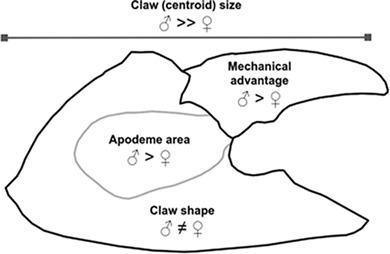当前位置:
X-MOL 学术
›
J. Morphol.
›
论文详情
Our official English website, www.x-mol.net, welcomes your
feedback! (Note: you will need to create a separate account there.)
Harder, better, faster, stronger: Weapon size is more sexually dimorphic than weapon biomechanical components in two freshwater anomuran species
Journal of Morphology ( IF 1.5 ) Pub Date : 2020-07-18 , DOI: 10.1002/jmor.21234 Alexandre V Palaoro 1, 2, 3 , Danilo G Muniz 1 , Sandro Santos 3
Journal of Morphology ( IF 1.5 ) Pub Date : 2020-07-18 , DOI: 10.1002/jmor.21234 Alexandre V Palaoro 1, 2, 3 , Danilo G Muniz 1 , Sandro Santos 3
Affiliation

|
Sexual selection influences the evolution of morphological traits that increase the likelihood of monopolizing scarce resources. When such traits are used during contests, they are termed weapons. Given that resources are typically linked to monopolizing mating partners, theory expects only males to bear weapons. In some species, however, females also bear weapons, although typically smaller than male weapons. Understanding why females bear smaller weapons can thus help us understand the selective pressures behind weapon evolution. However, most of our knowledge comes from studies on weapon size, while the biomechanics of weapons, such as the size of the muscles, efficiency, and shape are seldom studied. Our goal was to test if the theoretical expectations for weapon size sexual dimorphism also occur for weapon biomechanics using two aeglid crab species. Males of both species had larger claws which were also stronger than female claws. Male claws were also more efficient than females' claws (although we used only one species in this analysis). For weapon shape, though, only one species differed in the mean claw shape. Regarding scaling differences, in both species, male claws had higher size scaling than females, while only one species had a higher shape scaling. However, male weapons did not have higher scaling regarding strength and efficiency than females. Thus, males apparently allocate more resources in weapons than females, but once allocated, muscle and efficiency follow a similar developmental pathway in both sexes. Taken together, our results show that sexual dimorphism in weapons involves more than differences in size. Shape differences are especially intriguing because we cannot fully understand its causes. Yet, we highlight that such subtle differences can only be detected by measuring and analysing weapon shape and biomechanical components. Only then we might better understand how weapons are forged.
中文翻译:

更硬、更好、更快、更强:在两种淡水异兽物种中,武器尺寸比武器生物力学组件更具性别二态性
性选择会影响形态特征的进化,从而增加垄断稀缺资源的可能性。当在比赛中使用这些特性时,它们被称为武器。鉴于资源通常与垄断交配伙伴有关,理论上预计只有雄性才会携带武器。然而,在某些物种中,雌性也携带武器,尽管通常比雄性武器小。了解为什么女性携带较小的武器可以帮助我们了解武器进化背后的选择压力。然而,我们的大部分知识都来自对武器尺寸的研究,而很少研究武器的生物力学,例如肌肉的大小、效率和形状。我们的目标是测试武器大小性别二态性的理论预期是否也适用于使用两种 aeglid 蟹物种的武器生物力学。两个物种的雄性都有较大的爪子,也比雌性的爪子强壮。雄性的爪子也比雌性的爪子更有效率(虽然我们在这个分析中只使用了一个物种)。然而,就武器形状而言,只有一种物种的平均爪形有所不同。关于鳞片差异,在两个物种中,雄性爪的大小鳞片比雌性大,而只有一个物种的形状鳞片更高。然而,男性武器在力量和效率方面并没有比女性更高。因此,男性显然比女性分配更多的武器资源,但一旦分配,肌肉和效率在两性中都遵循相似的发展途径。综合起来,我们的结果表明,武器中的性别二态性不仅仅涉及尺寸差异。形状差异特别有趣,因为我们无法完全理解其原因。然而,我们强调只有通过测量和分析武器形状和生物力学组件才能检测到这种细微的差异。只有这样,我们才能更好地了解武器是如何锻造的。
更新日期:2020-07-18
中文翻译:

更硬、更好、更快、更强:在两种淡水异兽物种中,武器尺寸比武器生物力学组件更具性别二态性
性选择会影响形态特征的进化,从而增加垄断稀缺资源的可能性。当在比赛中使用这些特性时,它们被称为武器。鉴于资源通常与垄断交配伙伴有关,理论上预计只有雄性才会携带武器。然而,在某些物种中,雌性也携带武器,尽管通常比雄性武器小。了解为什么女性携带较小的武器可以帮助我们了解武器进化背后的选择压力。然而,我们的大部分知识都来自对武器尺寸的研究,而很少研究武器的生物力学,例如肌肉的大小、效率和形状。我们的目标是测试武器大小性别二态性的理论预期是否也适用于使用两种 aeglid 蟹物种的武器生物力学。两个物种的雄性都有较大的爪子,也比雌性的爪子强壮。雄性的爪子也比雌性的爪子更有效率(虽然我们在这个分析中只使用了一个物种)。然而,就武器形状而言,只有一种物种的平均爪形有所不同。关于鳞片差异,在两个物种中,雄性爪的大小鳞片比雌性大,而只有一个物种的形状鳞片更高。然而,男性武器在力量和效率方面并没有比女性更高。因此,男性显然比女性分配更多的武器资源,但一旦分配,肌肉和效率在两性中都遵循相似的发展途径。综合起来,我们的结果表明,武器中的性别二态性不仅仅涉及尺寸差异。形状差异特别有趣,因为我们无法完全理解其原因。然而,我们强调只有通过测量和分析武器形状和生物力学组件才能检测到这种细微的差异。只有这样,我们才能更好地了解武器是如何锻造的。











































 京公网安备 11010802027423号
京公网安备 11010802027423号